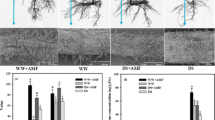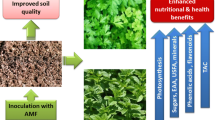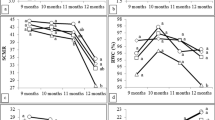Abstract
The present study was undertaken to determine the effect of inoculation with arbuscular mycorrhizal fungi (AMF) from natural and cultivated tea rhizospheres (NTR and CTR, respectively) on growth as well as on quality parameters of tea [Camellia sinensis (L.) O. Kuntze]. Seeds (after germination) and cuttings were inoculated with AMF consortia from NTR and CTR in non-sterilized acid soil (pH 5.0). Seedlings and cuttings were grown under net-house conditions and the data on growth and quality parameters were recorded up to 2 years. Tea plants were found to be highly colonized by AMF (74–83%) after 1 year. The significant increase in most of the growth parameters (root/shoot length, dry weight; r/s ratio) was recorded in AMF-treated plants, which also showed better tea quality parameters than noninoculated plants. Maximum significant increases up to 31% and 100%, over control, were recorded in amino acids and total protein content, respectively. Similarly, maximum increase in total polyphenols (15%) and caffeine content (34%) over control was also significant. Enhanced sugar content (maximum 16% in total soluble sugars, maximum 45% in reducing sugars, and maximum 69% in non-reducing sugars) was recorded in AMF-inoculated plants. In most cases, better response was observed in tea plants inoculated with AMF consortia from NTR. These results indicate that growth and quality of tea can be improved by AMF inoculations in acid soils.
Similar content being viewed by others
References
Clark RB (1997) Arbuscular mycorrhizal adaptation, spore germination, root colonization and host plant growth and mineral acquisition at low pH. Plant Soil 192:15–22
Clark RB, Zeto SK (1996) Growth and root colonization of mycorrhizal maize grown on acid and alkaline soil. Soil Biol Biochem 28:1505–1511
Clark RB, Zeto SK, Zobel RW (1999) Arbuscular mycorrhizal fungal isolate effectiveness on growth and root colonization of Panicum virgatum in acidic soil. Soil Biol Biochem 31:1757–1763
Cooperband LR, Boener REJ, Logan TJ (1994) Humid tropical leguminous tree and pasture grass responsiveness to vesicular-arbuscular mycorrhizal infection. Mycorrhiza 4:233–239
Dubois M, Gilles KA, Hamilton JK, Roberts PA, Smith F (1956) Colorimetric method for determination of sugars and related substances. Determination of concentration of pure sugar solution. Ann Chemistry 28:350–360
Foy CD (1992) Soil chemical factors limiting plant root growth. Adv Soil Sci 19:87–149
Gaur A, Adholeya A (1999) Mycorrhizal effects on the acclimatization, survival, growth and chlorophyll of micropropagated Syngonium and Draceana inoculated at weaning and hardening stages. Mycorrhiza 9:215–219
Gazey C, Abbott LK, Robson AD (2004) Indigenous and introduced arbuscular mycorrhizal fungi contribute to plant growth in two agricultural soils from south-western Australia. Mycorrhiza 14:355–362
Gulati A, Ravindranath SD (1996) Seasonal variation in quality of Kangra tea (Camellia sinensis (L) O Kuntze) in Himachal Pradesh. J Sci Food Agricul 71:231–236
Gurumani N (2005) An Introduction to Biostatistics. MJP, Chennai
Habte M, Byappanahalli MN (1994) Dependency of cassava (Manihot esculanta Crantz) on vesicular-arbuscular mycorrhizal fungi. Mycorrrhiza 4:241–245
Hilton PJ, Palmer-Jones R, Ellis RT (1973) Effect of season and nitrogen fertilizer upon the flavanol composition and tea making quality of fresh shoots of tea (Camellia sinensis L.) in Central Africa. J Sci Food Agricul 24:819–826
Janos DP (1980) vesicular-arbuscular mycorrhizae affect lowland tropical rain forest plant growth. Ecology 61:151–162
Janos DP, Schroeder MS, Schaffer B, Crane JH (2001) Inoculation with arbuscular mycorrhizal fungi enhance growth of Litchi chinensis Sonn. trees after propagation by air layering. Plant Soil 233:85–94
Koomen I, Grace C, Hayman DS (1987) Effectiveness of single and multiple mycorrhizal inocula on growth of clover on strawberry plants at two soil pHs. Soil Biol Biochem 19:539–544
Lin Z, Wu X, Wang X, Yu Y (1992) Studies on phosphorus nutrition in red soil of tea field. In: Tea Science research Proceedings. Tea Research Institute of Chinese Academy of Agricultural Science. Shanghai Scientific and Technological Publisher, Shanghai
Lowry OH, Rosenbrough NJ, Farr AL, Randall RJ (1951) Protein measurements with the folin phenol reagent. J Biol Biochem 193:265–275
Maddox JJ, Soileau JM (1991) Effect of phosphate fertilization, lime amendments and inoculation with VA-mycorrhizal fungi on soybeans in an acid soil. Plant Soil 134:83–93
Marschner H (1991) Mechanisms of adaptation of plants to acid soils. Plant Soil 134:1–20
Mumin A, Akhter KF, Abedin Z, Hossain Z (2006) Determination and characterization of caffeine in tea, coffee and soft drinks by solid phase extraction and high performance liquid chromatography (SPE–HPLC). Malaysian J Chem 8:45–51
Pandey A, Palni LMS (1996) The rhizosphere effect of tea on soil microbes in a Himalayan monsoonal location. Biol Fertil Soils 21:131–137
Pandey A, Palni LMS (1997) Bacillus species: the dominant bacteria of the rhizosphere of established tea bushes. Microbiol Res 152:359–365
Pandey A, Palni LMS (2004) Tea rhizosphere: microbial diversity and characteristic features and comments on microbial communication in rhizosphere. Inter J Tea Sci 3:285–290
Pandey A, Palni LMS, Coulomb N (1997) Antifungal activity of bacteria isolated from the rhizosphere of established tea bushes. Microbiol Res 152:105–112
Pandey A, Palni LMS, Bag N (2000) Biological hardening of tissue culture raised tea plants through rhizosphere bacteria. Biotechnol Lett 22:1087–1091
Pandey A, Palni LMS, Bisht D (2001) Dominant fungi in the rhizosphere of established tea bushes and their interaction with the dominant bacteria under in situ condition. Microbiol Res 156:377–382
Phillips JM, Hayman DS (1970) Improved procedure for clearing roots and staining parasitic and vesicular arbuscular mycorrhizal fungi for rapid assessment of infections. Transaction British Mycol Soc 55:158–161
Sadasivam S, Manickam A (2003) Biochemical Methods, 2nd edn. New Age International (P) Ltd, New Delhi
Schroeder MS, Janos DP (2004) Phosphorus and intraspecific density alter plant responses to arbuscular mycorrhizas. Plant Soil 264:335–348
Sieverding E (1991) Vesicular-arbuscular mycorrhiza management in tropical agrosystems. Deutsche Gesellschaft Technische Zusammenarbeit (GTZ), Eschborn
Singh S, Pandey A, Chaurasia B, Palni LMS (2008a) Diversity of arbuscular mycorrhizal fungi associated with the rhizosphere of tea growing in ‘natural’ and ‘cultivated’ ecosites. Biol Fertil Soils 44:491–500
Singh S, Pandey A, Palni LMS (2008b) Screening of arbuscular mycorrhizal fungal consortia developed from the rhizospheres of natural and cultivated tea plants for growth promotion in tea [Camellia sinensis (L.) O. Kuntze]. Pedobiologia 52:119–125
Singleton VL, Rossi JA (1965) Colorimetry of total phenolics with phosphomolybdic-phosphotungstic acid reagents. American J Enol Viticulture 16:144–158
Sumner JB, Howell SF (1935) A colorimetric estimation of reducing sugars in potatoes with 3, 5-dinitrosalicylic acid. Potato Res 16:176–179
Yaminishi T (1999) Tea flavour. In: Jain NK (ed) Global advances in tea science. Aravali Books International (P) Ltd, New Delhi, pp 707–722
Acknowledgments
Authors are thankful to Science and Society Division, Department of Science and Technology, New Delhi, Government of India, Department of Biotechnology and Union Ministry of Environment and Forests, Government of India, New Delhi for financial support.
Author information
Authors and Affiliations
Corresponding author
Rights and permissions
About this article
Cite this article
Singh, S., Pandey, A., Kumar, B. et al. Enhancement in growth and quality parameters of tea [Camellia sinensis (L.) O. Kuntze] through inoculation with arbuscular mycorrhizal fungi in an acid soil. Biol Fertil Soils 46, 427–433 (2010). https://doi.org/10.1007/s00374-010-0448-x
Received:
Revised:
Accepted:
Published:
Issue Date:
DOI: https://doi.org/10.1007/s00374-010-0448-x




